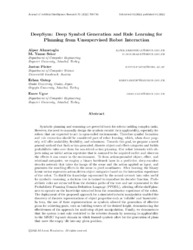Deepsym: Deep symbol generation and rule learning for planning from unsupervised robot interaction
| dc.contributor.author | Ahmetoglu, A. | |
| dc.contributor.author | Seker, M. Y. | |
| dc.contributor.author | Piater, J. | |
| dc.contributor.author | Öztop, Erhan | |
| dc.contributor.author | Ugur, E. | |
| dc.date.accessioned | 2023-08-04T08:28:59Z | |
| dc.date.available | 2023-08-04T08:28:59Z | |
| dc.date.issued | 2022 | |
| dc.identifier.issn | 1076-9757 | en_US |
| dc.identifier.uri | http://hdl.handle.net/10679/8566 | |
| dc.identifier.uri | https://www.jair.org/index.php/jair/article/view/13754 | |
| dc.description.abstract | Symbolic planning and reasoning are powerful tools for robots tackling complex tasks. However, the need to manually design the symbols restrict their applicability, especially for robots that are expected to act in open-ended environments. Therefore symbol formation and rule extraction should be considered part of robot learning, which, when done properly, will offer scalability, flexibility, and robustness. Towards this goal, we propose a novel general method that finds action-grounded, discrete object and effect categories and builds probabilistic rules over them for non-trivial action planning. Our robot interacts with objects using an initial action repertoire that is assumed to be acquired earlier and observes the effects it can create in the environment. To form action-grounded object, effect, and relational categories, we employ a binary bottleneck layer in a predictive, deep encoder-decoder network that takes the image of the scene and the action applied as input, and generates the resulting effects in the scene in pixel coordinates. After learning, the binary latent vector represents action-driven object categories based on the interaction experience of the robot. To distill the knowledge represented by the neural network into rules useful for symbolic reasoning, a decision tree is trained to reproduce its decoder function. Probabilistic rules are extracted from the decision paths of the tree and are represented in the Probabilistic Planning Domain Definition Language (PPDDL), allowing off-the-shelf planners to operate on the knowledge extracted from the sensorimotor experience of the robot. The deployment of the proposed approach for a simulated robotic manipulator enabled the discovery of discrete representations of object properties such as 'rollable' and 'insertable'. In turn, the use of these representations as symbols allowed the generation of effective plans for achieving goals, such as building towers of the desired height, demonstrating the effectiveness of the approach for multi-step object manipulation. Finally, we demonstrate that the system is not only restricted to the robotics domain by assessing its applicability to the MNIST 8-puzzle domain in which learned symbols allow for the generation of plans that move the empty tile into any given position. | en_US |
| dc.description.sponsorship | Japan Society for the Promotion of Science ; Osaka University ; TÜBİTAK ; Bilim Akademisi | |
| dc.language.iso | eng | en_US |
| dc.publisher | AI Access Foundation | en_US |
| dc.relation | info:turkey/grantAgreement/TUBITAK/120E274 | |
| dc.relation.ispartof | Journal of Artificial Intelligence Research | |
| dc.rights | openAccess | |
| dc.title | Deepsym: Deep symbol generation and rule learning for planning from unsupervised robot interaction | en_US |
| dc.type | Article | en_US |
| dc.description.version | Publisher version | en_US |
| dc.peerreviewed | yes | en_US |
| dc.publicationstatus | Published | en_US |
| dc.contributor.department | Özyeğin University | |
| dc.contributor.authorID | (ORCID 0000-0002-3051-6038 & YÖK ID 45227) Öztop, Erhan | |
| dc.contributor.ozuauthor | Öztop, Erhan | |
| dc.identifier.volume | 75 | en_US |
| dc.identifier.startpage | 709 | en_US |
| dc.identifier.endpage | 745 | en_US |
| dc.identifier.wos | WOS:000884418500002 | |
| dc.identifier.doi | 10.1613/JAIR.1.13754 | en_US |
| dc.identifier.scopus | SCOPUS:2-s2.0-85147540666 | |
| dc.relation.publicationcategory | Article - International Refereed Journal - Institutional Academic Staff |
Files in this item
This item appears in the following Collection(s)
Share this page



